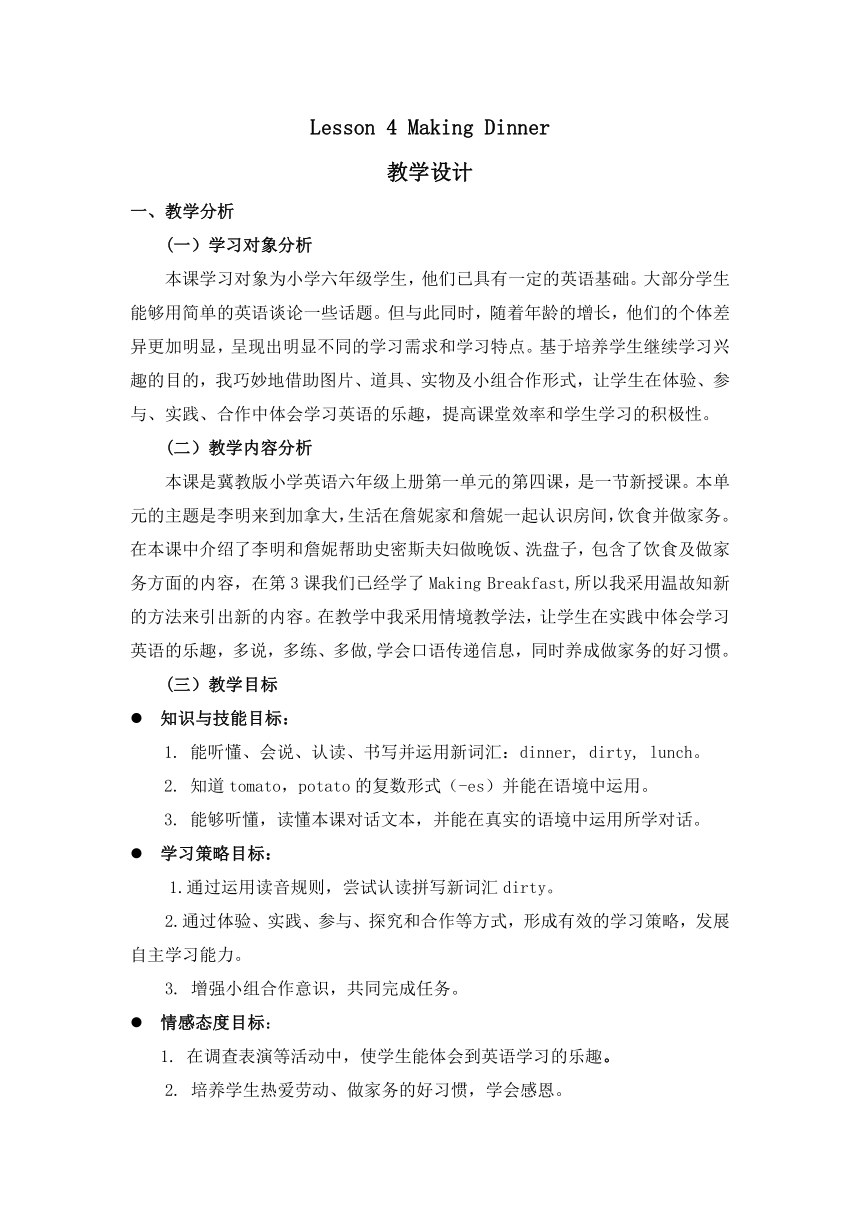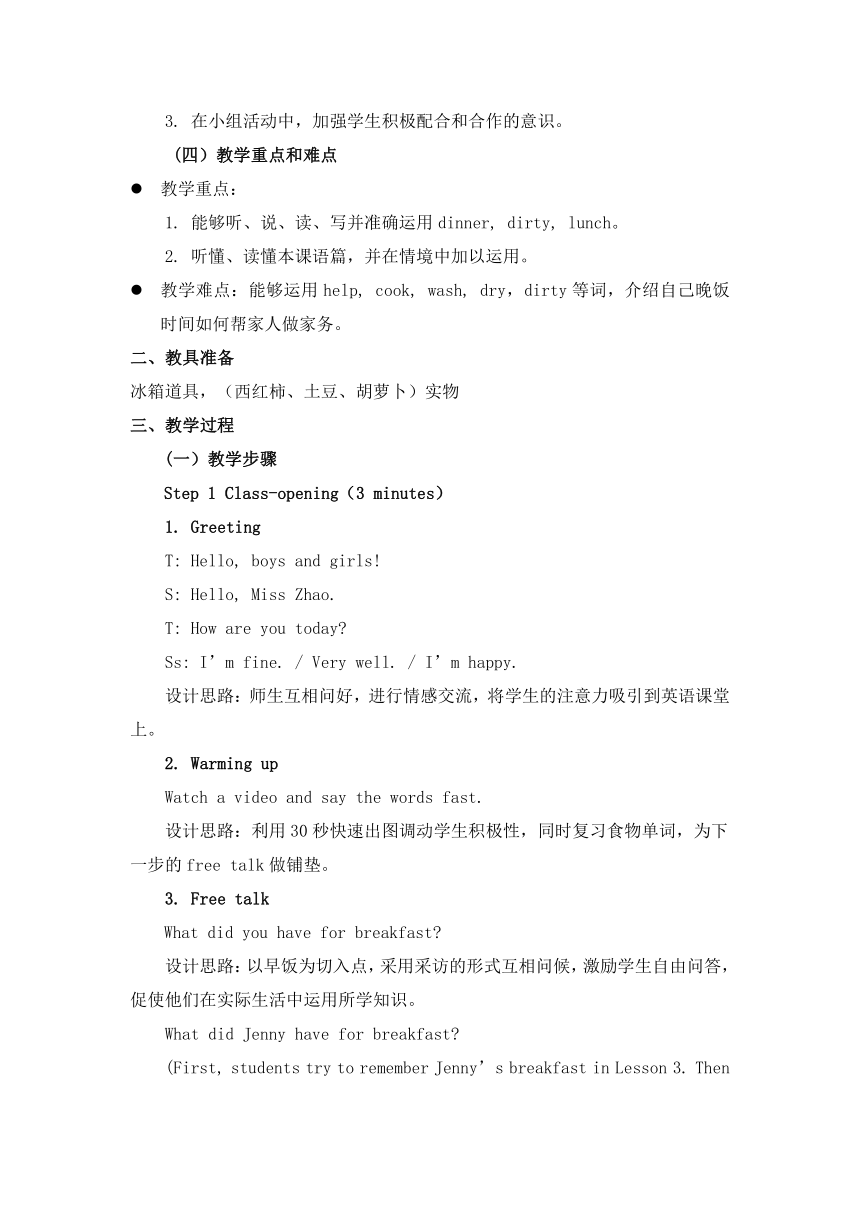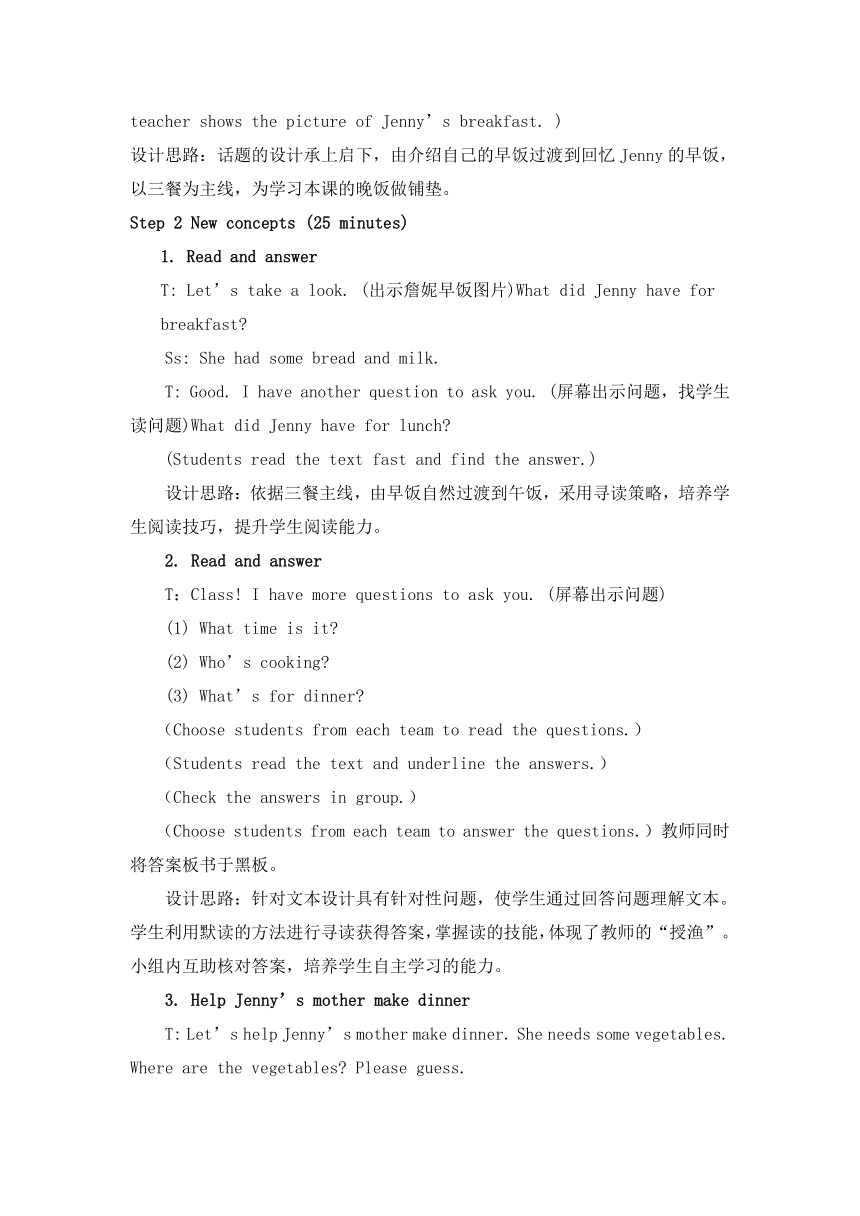Lesson 4 Making dinner 教案
文档属性
| 名称 | Lesson 4 Making dinner 教案 |  | |
| 格式 | zip | ||
| 文件大小 | 138.2KB | ||
| 资源类型 | 教案 | ||
| 版本资源 | 冀教版(三年级起点) | ||
| 科目 | 英语 | ||
| 更新时间 | 2016-08-17 11:28:54 | ||
图片预览



文档简介
Lesson
4
Making
Dinner
教学设计
一、教学分析
(一)学习对象分析
本课学习对象为小学六年级学生,他们已具有一定的英语基础。大部分学生能够用简单的英语谈论一些话题。但与此同时,随着年龄的增长,他们的个体差异更加明显,呈现出明显不同的学习需求和学习特点。基于培养学生继续学习兴趣的目的,我巧妙地借助图片、道具、实物及小组合作形式,让学生在体验、参与、实践、合作中体会学习英语的乐趣,提高课堂效率和学生学习的积极性。
(二)教学内容分析
本课是冀教版小学英语六年级上册第一单元的第四课,是一节新授课。本单元的主题是李明来到加拿大,生活在詹妮家和詹妮一起认识房间,饮食并做家务。在本课中介绍了李明和詹妮帮助史密斯夫妇做晚饭、洗盘子,包含了饮食及做家务方面的内容,在第3课我们已经学了Making
Breakfast,所以我采用温故知新的方法来引出新的内容。在教学中我采用情境教学法,让学生在实践中体会学习英语的乐趣,多说,多练、多做,学会口语传递信息,同时养成做家务的好习惯。
(三)教学目标
知识与技能目标:
能听懂、会说、认读、书写并运用新词汇:dinner,
dirty,
lunch。
2.
知道tomato,potato的复数形式(-es)并能在语境中运用。
3.
能够听懂,读懂本课对话文本,并能在真实的语境中运用所学对话。
学习策略目标:
1.通过运用读音规则,尝试认读拼写新词汇dirty。
2.通过体验、实践、参与、探究和合作等方式,形成有效的学习策略,发展自主学习能力。
3.
增强小组合作意识,共同完成任务。
情感态度目标:
1.
在调查表演等活动中,使学生能体会到英语学习的乐趣。
2.
培养学生热爱劳动、做家务的好习惯,学会感恩。
3.
在小组活动中,加强学生积极配合和合作的意识。
(四)教学重点和难点
教学重点:
1.
能够听、说、读、写并准确运用dinner,
dirty,
lunch。
2.
听懂、读懂本课语篇,并在情境中加以运用。
教学难点:能够运用help,
cook,
wash,
dry,dirty等词,介绍自己晚饭时间如何帮家人做家务。
二、教具准备
冰箱道具,(西红柿、土豆、胡萝卜)实物
三、教学过程
(一)教学步骤
Step
1
Class-opening(3
minutes)
1.
Greeting
T:
Hello,
boys
and
girls!
S:
Hello,
Miss
Zhao.
T:
How
are
you
today
Ss:
I’m
fine.
/
Very
well.
/
I’m
happy.
设计思路:师生互相问好,进行情感交流,将学生的注意力吸引到英语课堂上。
2.
Warming
up
Watch
a
video
and
say
the
words
fast.
设计思路:利用30秒快速出图调动学生积极性,同时复习食物单词,为下一步的free
talk做铺垫。
3.
Free
talk
What
did
you
have
for
breakfast
设计思路:以早饭为切入点,采用采访的形式互相问候,激励学生自由问答,促使他们在实际生活中运用所学知识。
What
did
Jenny
have
for
breakfast
(First,
students
try
to
remember
Jenny’s
breakfast
in
Lesson
3.
Then
teacher
shows
the
picture
of
Jenny’s
breakfast.
)
设计思路:话题的设计承上启下,由介绍自己的早饭过渡到回忆Jenny的早饭,以三餐为主线,为学习本课的晚饭做铺垫。
Step
2
New
concepts
(25
minutes)
Read
and
answer
T:
Let’s
take
a
look.
(出示詹妮早饭图片)What
did
Jenny
have
for
breakfast
Ss:
She
had
some
bread
and
milk.
T:
Good.
I
have
another
question
to
ask
you.
(屏幕出示问题,找学生读问题)What
did
Jenny
have
for
lunch
(Students
read
the
text
fast
and
find
the
answer.)
设计思路:依据三餐主线,由早饭自然过渡到午饭,采用寻读策略,培养学生阅读技巧,提升学生阅读能力。
2.
Read
and
answer
T:Class!
I
have
more
questions
to
ask
you.
(屏幕出示问题)
(1)
What
time
is
it
(2)
Who’s
cooking
(3)
What’s
for
dinner
(Choose
students
from
each
team
to
read
the
questions.)
(Students
read
the
text
and
underline
the
answers.)
(Check
the
answers
in
group.)
(Choose
students
from
each
team
to
answer
the
questions.)教师同时将答案板书于黑板。
设计思路:针对文本设计具有针对性问题,使学生通过回答问题理解文本。学生利用默读的方法进行寻读获得答案,掌握读的技能,体现了教师的“授渔”。小组内互助核对答案,培养学生自主学习的能力。
3.
Help
Jenny’s
mother
make
dinner
T:
Let’s
help
Jenny’s
mother
make
dinner.
She
needs
some
vegetables.
Where
are
the
vegetables
Please
guess.
S1:
They
are
in
the
fridge.
S2:
They
are
...
T:Class!
Please
look!
What’s
this
(教师出示冰箱道具)
What’s
in
the
fridge
(Students
try
to
guess
what’s
in
the
fridge.)
(Students
look
inside
the
fridge
and
answer
the
question.)
(
接着出示西红柿在冰箱图片,同样方式出示胡萝卜土豆在桌子上图片)
(Students
look
at
the
pictures
and
say.)
学生说完以后出示句子。
(Students
read
and
find
the
rules
about
potatoes
and
tomatoes.)学生试着发现以o结尾的名词复数的规律,在教师的提示下加以总结。
T:
Li
Ming
and
Jenny
like
potatoes
and
tomatoes.
Now
dinner’s
ready.
I
think
it’s
yummy.
What
do
you
want
to
say
What
does
Li
Ming
say (出示语句)
设计思路:使用冰箱的道具,让学生猜一猜蔬菜在哪里,冰箱里有什么,为课堂增添生活色彩。让学生真正体验、参与,发现,总结,从而形成有效学习策略。
4.
Listen,
read
and
answer
After
dinner...
(出示问题)
(1)
Who
washes
the
dirty
dishes
(2)
What
does
Li
Ming
do
(Choose
students
from
each
team
to
read
the
questions.)读完第一个问题出示脏盘子图片。
(Students
listen,
read
and
answer
the
questions.)
(Check
the
answers
in
group.)
(Choose
students
from
each
team
to
answer
the
questions.)教师同时将答案板书于黑板。
设计思路:利用听读找答案的形式,理解文本第二部分,锻炼学生的听读能力。同时问题的设计对学生进行了爱劳动做家务的情感渗透。小组内互助核对答案,充分体现学生主体性,培养学生自主学习的能力。
Practice
1.
Make
a
survey
T:
Now
Let’s
talk
about
Jenny.
(出示相关表格)
What’s
the
time
for
dinner
What’s
for
dinner
name
time
dinner
Jenny
T:
Do
you
want
to
know
about
me
T:
Now
choose
one
of
your
friends
to
make
a
survey.
(Students
try
to
make
the
survey.)
(Share
in
class.)
设计思路:巩固文本后跳出文本,通过体验、实践、参与、探究和合作等方式,在真实的生活情境中沟通交流问候,考查学生的综合运用能力。
2.
Do
the
exercise
of
part
3
T:
Now
Let’s
talk
about
the
Smith.(出示part
3
Match
and
write)
Picture
5
Mrs.
Smith
is
in
the
kitchen.
She
is
going
to
______
dinner.
Next
one
is
picture
4.
OK!Please
do
it.
·Students
do
the
exercise
by
themselves.
·Check
the
exercise
in
group.
·Check
the
exercise
in
class.
设计思路:检验学生学习效果。通过小组内互助核对答案,充分体现学生主体性,培养学生自主学习的能力。同时也能使老师退出课堂,扮演“观察者”,从而更好的激励学生。
Step
3
Activity
(6
minutes)
Group
work
Topic:
Time
for
dinner.
What
do
you
do
for
dinner
·Talk
in
the
group
and
then
write
it
down.
·Share
the
topic
in
class.
设计思路:围绕本课主线(Making
Dinner)进行,根据所给出的情境进行书写训练,使学生在英语学习过程中发展综合语言运用能力。在小组活动中,加强学生积极配合和合作的意识。学生在这个过程中经历“语言输入—语言理解—语言输出”三个环节的训练,使学会如何学习,同时使学生在活动中养成爱劳动做家务的好习惯。
Step
4
Class
Closing
(1
minute)
1.
Summary
(依据板书进行巩固复述)
设计思路:巩固扎实,总结本课所学。
2.Homework
·Listen
and
read
Lesson
4.
·Finish
your
writing.
设计思路:设计听读作业使学生巩固所学内容,提高听读的能力。写作的布置是课堂的延伸,锻炼学生写作的能力,帮助不同程度的学生在自己原有程度上有所提高和进步,尽量得到最多的收获。
(二)板书设计
Lesson
4
Making
Dinner
T1
T2
Time
for
dinner.
cook
meat
and
vegetables.
help
potatoes
tomatoes
carrots
wash
the
dirty
dishes.
dry
the
dishes.
4
Making
Dinner
教学设计
一、教学分析
(一)学习对象分析
本课学习对象为小学六年级学生,他们已具有一定的英语基础。大部分学生能够用简单的英语谈论一些话题。但与此同时,随着年龄的增长,他们的个体差异更加明显,呈现出明显不同的学习需求和学习特点。基于培养学生继续学习兴趣的目的,我巧妙地借助图片、道具、实物及小组合作形式,让学生在体验、参与、实践、合作中体会学习英语的乐趣,提高课堂效率和学生学习的积极性。
(二)教学内容分析
本课是冀教版小学英语六年级上册第一单元的第四课,是一节新授课。本单元的主题是李明来到加拿大,生活在詹妮家和詹妮一起认识房间,饮食并做家务。在本课中介绍了李明和詹妮帮助史密斯夫妇做晚饭、洗盘子,包含了饮食及做家务方面的内容,在第3课我们已经学了Making
Breakfast,所以我采用温故知新的方法来引出新的内容。在教学中我采用情境教学法,让学生在实践中体会学习英语的乐趣,多说,多练、多做,学会口语传递信息,同时养成做家务的好习惯。
(三)教学目标
知识与技能目标:
能听懂、会说、认读、书写并运用新词汇:dinner,
dirty,
lunch。
2.
知道tomato,potato的复数形式(-es)并能在语境中运用。
3.
能够听懂,读懂本课对话文本,并能在真实的语境中运用所学对话。
学习策略目标:
1.通过运用读音规则,尝试认读拼写新词汇dirty。
2.通过体验、实践、参与、探究和合作等方式,形成有效的学习策略,发展自主学习能力。
3.
增强小组合作意识,共同完成任务。
情感态度目标:
1.
在调查表演等活动中,使学生能体会到英语学习的乐趣。
2.
培养学生热爱劳动、做家务的好习惯,学会感恩。
3.
在小组活动中,加强学生积极配合和合作的意识。
(四)教学重点和难点
教学重点:
1.
能够听、说、读、写并准确运用dinner,
dirty,
lunch。
2.
听懂、读懂本课语篇,并在情境中加以运用。
教学难点:能够运用help,
cook,
wash,
dry,dirty等词,介绍自己晚饭时间如何帮家人做家务。
二、教具准备
冰箱道具,(西红柿、土豆、胡萝卜)实物
三、教学过程
(一)教学步骤
Step
1
Class-opening(3
minutes)
1.
Greeting
T:
Hello,
boys
and
girls!
S:
Hello,
Miss
Zhao.
T:
How
are
you
today
Ss:
I’m
fine.
/
Very
well.
/
I’m
happy.
设计思路:师生互相问好,进行情感交流,将学生的注意力吸引到英语课堂上。
2.
Warming
up
Watch
a
video
and
say
the
words
fast.
设计思路:利用30秒快速出图调动学生积极性,同时复习食物单词,为下一步的free
talk做铺垫。
3.
Free
talk
What
did
you
have
for
breakfast
设计思路:以早饭为切入点,采用采访的形式互相问候,激励学生自由问答,促使他们在实际生活中运用所学知识。
What
did
Jenny
have
for
breakfast
(First,
students
try
to
remember
Jenny’s
breakfast
in
Lesson
3.
Then
teacher
shows
the
picture
of
Jenny’s
breakfast.
)
设计思路:话题的设计承上启下,由介绍自己的早饭过渡到回忆Jenny的早饭,以三餐为主线,为学习本课的晚饭做铺垫。
Step
2
New
concepts
(25
minutes)
Read
and
answer
T:
Let’s
take
a
look.
(出示詹妮早饭图片)What
did
Jenny
have
for
breakfast
Ss:
She
had
some
bread
and
milk.
T:
Good.
I
have
another
question
to
ask
you.
(屏幕出示问题,找学生读问题)What
did
Jenny
have
for
lunch
(Students
read
the
text
fast
and
find
the
answer.)
设计思路:依据三餐主线,由早饭自然过渡到午饭,采用寻读策略,培养学生阅读技巧,提升学生阅读能力。
2.
Read
and
answer
T:Class!
I
have
more
questions
to
ask
you.
(屏幕出示问题)
(1)
What
time
is
it
(2)
Who’s
cooking
(3)
What’s
for
dinner
(Choose
students
from
each
team
to
read
the
questions.)
(Students
read
the
text
and
underline
the
answers.)
(Check
the
answers
in
group.)
(Choose
students
from
each
team
to
answer
the
questions.)教师同时将答案板书于黑板。
设计思路:针对文本设计具有针对性问题,使学生通过回答问题理解文本。学生利用默读的方法进行寻读获得答案,掌握读的技能,体现了教师的“授渔”。小组内互助核对答案,培养学生自主学习的能力。
3.
Help
Jenny’s
mother
make
dinner
T:
Let’s
help
Jenny’s
mother
make
dinner.
She
needs
some
vegetables.
Where
are
the
vegetables
Please
guess.
S1:
They
are
in
the
fridge.
S2:
They
are
...
T:Class!
Please
look!
What’s
this
(教师出示冰箱道具)
What’s
in
the
fridge
(Students
try
to
guess
what’s
in
the
fridge.)
(Students
look
inside
the
fridge
and
answer
the
question.)
(
接着出示西红柿在冰箱图片,同样方式出示胡萝卜土豆在桌子上图片)
(Students
look
at
the
pictures
and
say.)
学生说完以后出示句子。
(Students
read
and
find
the
rules
about
potatoes
and
tomatoes.)学生试着发现以o结尾的名词复数的规律,在教师的提示下加以总结。
T:
Li
Ming
and
Jenny
like
potatoes
and
tomatoes.
Now
dinner’s
ready.
I
think
it’s
yummy.
What
do
you
want
to
say
What
does
Li
Ming
say (出示语句)
设计思路:使用冰箱的道具,让学生猜一猜蔬菜在哪里,冰箱里有什么,为课堂增添生活色彩。让学生真正体验、参与,发现,总结,从而形成有效学习策略。
4.
Listen,
read
and
answer
After
dinner...
(出示问题)
(1)
Who
washes
the
dirty
dishes
(2)
What
does
Li
Ming
do
(Choose
students
from
each
team
to
read
the
questions.)读完第一个问题出示脏盘子图片。
(Students
listen,
read
and
answer
the
questions.)
(Check
the
answers
in
group.)
(Choose
students
from
each
team
to
answer
the
questions.)教师同时将答案板书于黑板。
设计思路:利用听读找答案的形式,理解文本第二部分,锻炼学生的听读能力。同时问题的设计对学生进行了爱劳动做家务的情感渗透。小组内互助核对答案,充分体现学生主体性,培养学生自主学习的能力。
Practice
1.
Make
a
survey
T:
Now
Let’s
talk
about
Jenny.
(出示相关表格)
What’s
the
time
for
dinner
What’s
for
dinner
name
time
dinner
Jenny
T:
Do
you
want
to
know
about
me
T:
Now
choose
one
of
your
friends
to
make
a
survey.
(Students
try
to
make
the
survey.)
(Share
in
class.)
设计思路:巩固文本后跳出文本,通过体验、实践、参与、探究和合作等方式,在真实的生活情境中沟通交流问候,考查学生的综合运用能力。
2.
Do
the
exercise
of
part
3
T:
Now
Let’s
talk
about
the
Smith.(出示part
3
Match
and
write)
Picture
5
Mrs.
Smith
is
in
the
kitchen.
She
is
going
to
______
dinner.
Next
one
is
picture
4.
OK!Please
do
it.
·Students
do
the
exercise
by
themselves.
·Check
the
exercise
in
group.
·Check
the
exercise
in
class.
设计思路:检验学生学习效果。通过小组内互助核对答案,充分体现学生主体性,培养学生自主学习的能力。同时也能使老师退出课堂,扮演“观察者”,从而更好的激励学生。
Step
3
Activity
(6
minutes)
Group
work
Topic:
Time
for
dinner.
What
do
you
do
for
dinner
·Talk
in
the
group
and
then
write
it
down.
·Share
the
topic
in
class.
设计思路:围绕本课主线(Making
Dinner)进行,根据所给出的情境进行书写训练,使学生在英语学习过程中发展综合语言运用能力。在小组活动中,加强学生积极配合和合作的意识。学生在这个过程中经历“语言输入—语言理解—语言输出”三个环节的训练,使学会如何学习,同时使学生在活动中养成爱劳动做家务的好习惯。
Step
4
Class
Closing
(1
minute)
1.
Summary
(依据板书进行巩固复述)
设计思路:巩固扎实,总结本课所学。
2.Homework
·Listen
and
read
Lesson
4.
·Finish
your
writing.
设计思路:设计听读作业使学生巩固所学内容,提高听读的能力。写作的布置是课堂的延伸,锻炼学生写作的能力,帮助不同程度的学生在自己原有程度上有所提高和进步,尽量得到最多的收获。
(二)板书设计
Lesson
4
Making
Dinner
T1
T2
Time
for
dinner.
cook
meat
and
vegetables.
help
potatoes
tomatoes
carrots
wash
the
dirty
dishes.
dry
the
dishes.
同课章节目录
- Unit 1 Li Ming Goes to Canada
- Lesson 1 At the Airport
- Lesson 2 Jenny's House
- Lesson 3 Making Breakfast
- Lesson 4 Making Dinne
- Lesson 5 In the Living Room
- Lesson 6 Baby Becky at Home
- Unit 2 School in Canada
- Lesson 7 On the School Bus
- Lesson 8 Li Ming Meets Jenny's class
- Lesson 9 Mr. Wood Teaches a Lesson
- Lesson 10 How Many Are There ?
- Lesson 11 Always do your homework!
- Lesson 12 Be Safe on the Way
- Unit 3 Winter in canada
- Lesson 13 Seasons
- Lesson 14 Snow! It's Winter!
- Lesson 15 Winter Fun
- Lesson 16 A Skating Lesson
- Lesson 17 I Like All Seasons!
- Lesson 18 The Snowman
- Unit 4 Christmas
- Lesson 19 Christmas Is Coming!
- Lesson 20 Oh,Christmas Tree
- Lesson 21 Christmas Cards
- Lesson 22 Christmas Gifts
- Lesson 23 It's Christmas Morning!
- Lesson 24 Maddy's Christmas
